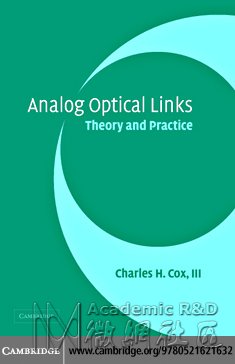Analog Optical Links Theory and Practice:
Preface page xi
1 Introduction 1
1.1 Background 1
1.2 Applications overview 8
1.2.1 Transmit optical links 8
1.2.2 Distribution optical links 9
1.2.3 Receive optical links 11
1.3 Optical fibers 12
References 17
2 Link components and their small-signal electro-optic models 19
2.1 Introduction 19
2.1.1 Notation 20
2.2 Modulation devices 20
2.2.1 Direct modulation 20
2.2.2 External modulation 34
2.3 Photodetectors 49
Appendix 2.1 Steady state (dc) rate equation model for
diode lasers 54
Appendix 2.2 Absorption coefficient of an electro-absorption
modulator 63
References 63
3 Low frequency, short length link models 69
3.1 Introduction 69
3.2 Small-signal intrinsic gain 70
3.2.1 Direct modulation 72
3.2.2 External modulation 74
3.3 Scaling of intrinsic gain 75
vii
viii Contents
3.3.1 Optical power 75
3.3.2 Wavelength 79
3.3.3 Modulation slope efficiency and photodetector
responsivity 81
3.4 Large signal intrinsic gain 82
Appendix 3.1 External modulation links and the Manley–Rowe
equations 87
References 88
4 Frequency response of links 91
4.1 Introduction 91
4.2 Frequency response of modulation and photodetection devices 93
4.2.1 Diode lasers 93
4.2.2 External modulators 98
4.2.3 Photodetectors 105
4.3 Passive impedance matching to modulation and photodetection
devices 110
4.3.1 PIN photodiode 112
4.3.2 Diode laser 117
4.3.3 Mach–Zehnder modulator 129
4.4 Bode–Fano limit 138
4.4.1 Lossy impedance matching 139
4.4.2 Lossless impedance matching 142
Appendix 4.1 Small signal modulation rate equation model for
diode lasers 152
References 156
5 Noise in links 159
5.1 Introduction 159
5.2 Noise models and measures 160
5.2.1 Noise sources 160
5.2.2 Noise figure 167
5.3 Link model with noise sources 168
5.3.1 General link noise model 168
5.3.2 RIN-dominated link 169
5.3.3 Shot-noise-dominated link 173
5.4 Scaling of noise figure 178
5.4.1 Impedance matching 179
5.4.2 Device slope efficiency 180
5.4.3 Average optical power 182
5.5 Limits on noise figure 185
5.5.1 Lossless passive match limit 185
Contents ix
5.5.2 Passive attenuation limit 187
5.5.3 General passive match limit 189
Appendix 5.1 Minimum noise figure of active and passive networks 196
References 199
6 Distortion in links 201
6.1 Introduction 201
6.2 Distortion models and measures 202
6.2.1 Power series distortion model 202
6.2.2 Measures of distortion 205
6.3 Distortion of common electro-optic devices 217
6.3.1 Diode laser 217
6.3.2 Mach–Zehnder modulator 222
6.3.3 Directional coupler modulator 225
6.3.4 Electro-absorption modulator 227
6.3.5 Photodiode 228
6.4 Methods for reducing distortion 232
6.4.1 Primarily electronic methods 233
6.4.2 Primarily optical methods 240
Appendix 6.1 Non-linear distortion rate equation model for
diode lasers 249
References 259
7 Link design tradeoffs 263
7.1 Introduction 263
7.2 Tradeoffs among intrinsic link parameters 263
7.2.1 Direct modulation 263
7.2.2 External modulation 268
7.2.3 SNR vs. noise limits and tradeoffs 273
7.3 Tradeoffs between intrinsic link and link with amplifiers 277
7.3.1 Amplifiers and link gain 277
7.3.2 Amplifiers and link frequency response 278
7.3.3 Amplifiers and link noise figure 278
7.3.4 Amplifiers and link IM-free dynamic range 279
References 284
Index 285
感谢楼主分享
{:7_1234:}{:7_1234:}

